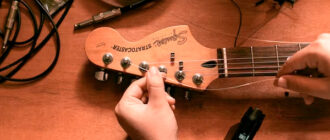There are many terms used in the guitar community, with the term “lick” being among the most mysterious you’ll come across while studying the guitar. We’ll provide a thorough explanation of this idea in this article. Thank goodness, you need not be afraid of the musical language. To learn more, just keep reading.
Regardless of whether you’re a novice or an expert guitarist, you have undoubtedly heard the terms “guitar riffs” and “guitar licks”.
Riffs and licks serve as the cornerstone for learning and improving the guitar playing and making fantastic music, particularly in styles like rock music, metal, hard rock.
Many individuals mistakenly use these two words interchangeably, or even believe they are interchangeable. Given the potential obvious similarities between them, this makes sense. However, they are actually pretty dissimilar in actuality.

What is a guitar riff vs lick?
Guitar riff
A guitar riff is the foundation of a musical composition, which aims to capture the mood of a song. Guitarists are not the only musicians who use musical riffs; it tends to depend on the song.
Riffs are a part of a song’s instrumental portion, and while they frequently belong to the rhythm section, this is not always the case.
Possibly the most well-known rock riff ever is from the iconic hard rock song “Smoke On The Water” by Deep Purple. You have undoubtedly heard the riff, even if you haven’t heard the song.
It is a superb illustration of what a good riff should be because it is straightforward, catchy, and memorable. The White Stripes’ song “Seven Nation Army” The White Stripes’ song Seven Nation Army contains another well-known riff.
The riff’s simple, rhythmic nature contributed to its popularity; you may hear it in a range of performances, activities, movies, and advertisements.
It’s crucial to realize that a riff’s primary goal is to be something that your ears will quickly recognize and remember.
You’ll start hearing the guitar riff of “Smoke on the Water” as soon as it’s mentioned. A riff’s composition largely relies on elements like rhythmic emphasis, repetition, and simplicity.
Even after hearing a guitar riff only once, you’ll probably remember it if it was successful in its development.

Guitar lick
Guitar players virtually exclusively use the word “licks” in contemporary culture, having popularized it. The purpose of a lick is to highlight the instrument in the musical composition of the entire song. It can be a very simple or complicated musical phrase.
A lick is most frequently employed in solos, melodic lines and accompaniment lines, albeit it isn’t always as distinctive as a riff (although it can be).
A lick is a fragment of musical idea that, when combined with other licks, can become a riff.
As guitar-based music developed, the importance of licks in the ability of a guitar player to demonstrate their degree of guitar playing proficiency increased.
The fundamental quality of good guitar licks is their melodic quality and how it links to all the little details a guitar player may add to it to give it character.
The best illustration of a master guitar player who can use simplicity and combine it with emotion through the technical expression of the guitar is B.B King. He truly exemplifies the ability to make a guitar “sing.”
The most crucial thing to keep in mind is that guitar licks are not a means of demonstrating your proficiency as a guitarist or how well or quick you can play.
Your first objective ought to be proficient communication in the musical language and show your originality through licks because they are similar to words.

Simple guidelines for learning guitar riffs and licks correctly
Pay close attention to the riff or lick
Enjoying music is a really easy activity to perform. But because of how busy we are, we seldom have time to actively enjoy music.
We don’t spend enough time internalizing what we just heard in our brains because we want to convey what we hear as quickly as possible from the ears to the fingers into the guitar.
In order to concentrate your attention and listen to the riffs and licks at least three times, set down your instrument and taking a deep breath.
The difficulty arises when you have to remember or absorb something new about the given lick each time you hear it. So, for instance, you might concentrate on the notes the first time, the rhythm the second time, and the articulation the third time.
This will greatly improve your musical hearing and inventiveness, as well as assist your brain truly capture and keep the knowledge you just consumed.

Don’t always depend on tabs
It is understandable that the quickest approach to get the results you’re after is to find tabs for whatever it is you’re wanting to study.
The reward is hearing that wonderful, rocking riffs and licks with your hands. And you are advised to do it. Playing the musical phrase will make you happy.
However, in the long picture, you are passing up a fantastic chance to improve your musicality in terms of ear training, understanding rhythm, and locating things on the guitar.
It is suggested that you learn your favorite riffs and licks using tabs, but that you also take the time to really understand the notes you are playing, how they correspond to the key you are in (if you are keen about music theory, which is highly recommended), and the rhythms that were used to create that lick or riff.
In the long term, this will unquestionably result in a more pleasant payoff for you.
The enjoyment is found along the way, not at the end
You have probably heard this before, yet there is such a strong truth to it. We want to learn all there is to know, and we want to learn it as soon as we can. We never want to slow down, for any reason, whether it’s impatience or a concern with falling behind.
But I’ll tell you right now that you’ll always want to know more, do more, and play better. You might be content with that good riff or lick for a few hours or days, but eventually you’ll become tired of it and desire to learn something new.
Enjoy it, take pleasure in the process of understanding something completely, and don’t waste time considering what will happen next. This is probably the most significant advice you’ll get.
Your chances of turning information into knowledge will be significantly increased if you approach learning with clarity and ease. Information is only a collection of meaningless words, whereas knowledge is power.

What exactly is a bass guitar lick?
A bass lick is exactly the same as a guitar lick, but it is played on the bass guitar. The same rules apply, and for a bass guitar, a bass lick is a brief phrase made up of a few bass notes.
Is lick the same as riff?
When compared to licks, riffs serve a totally different purpose.
By definition, a riff is finished on its own. It would still sound complete if the beginning of Metallica’s “Nothing Else Matters.” is played For a lick, the same cannot be stated. If a single lick were to be played, it would sound disjointed, jarring, and unintelligible.
I would differentiate by referring to a guitar riff as a musical notion that is typically in the lower register and serves as the melody’s main component. Riffs are typically single notes, though not always.
However, not every chord. I would never refer to Smells Like Teen Spirit, for example, as a riff. A lick is something that is more likely to be an augmentation to the main song in the upper register.
Any instrument can be used to perform a riff. But a lick is something that only guitars can do. A lick is meant to highlight the abilities of guitar players, whereas a riff is used to establish the mood.
Unlike riffs, licks provide guitar players the freedom to play solos or improvise over a song’s set melodic pattern.
Although licks might not have the same lasting power, there are memorable riffs.
Guitar riffs are a separate entity unlike licks
A guitar riff is essentially a whole musical phrase, with structure and repetition to make sure the listener hears and comprehends its entirety.
This differs significantly from a lick, which is essentially just a group of notes that are incomplete in and of itself and is sometimes employed to enhance a musical phrase or passage.
It is a separate entity as a result. A lick, on the other hand, is a fragment of a musical idea that, when combined with other licks, might form a riff. Consider a riff as a sentence, and a lick as the words that make up that statement.
Licks are a free domain, riffs are copyrighted
Guitar riffs are covered under the copyright claim legislation since they are recognizable and essential components of a song.
Without people knowing better, you couldn’t get away with using the guitar riff from “Beat It” in a song you claimed to be your own.
On the other side, because licks are brief musical phrases that everyone uses when playing, you can “borrow” as many as you like to create something original without worrying about violating anyone else’s copyright.
Licks are made to be used repeatedly on multiple songs, but with subtle alterations each time.
Riffs are more prone to composition and licks to improvisation
A guitar lick will very certainly be employed in a guitar solo play or improvisation setting because of the nature of the instrument.
Guitar players typically learn licks so that when it comes time to solo, they can find inspiration from the licks they have learned.
Alternately, riffs typically need time and attention to create in order to accomplish their purpose. Varying the beat, the pace, and a few notes here and there.
Composers take into account each of these factors to create the greatest rendition of the riff that fits the song’s mood and attitude.

Simple famous guitar riffs
Here are some simple guitar riffs to learn from the wonderful riffs found in rock and roll music. I chose not to include the most well-known riffs because there’s a chance you won’t be able to play at least one of them.
“Do I wanna know” by Arctic Monkeys
Arctic Monkeys must be included on any list of new wave rock bands. To allow both octaves room, lead guitarist and singer Alex Turner performs this riff live on a 12-string guitar. However, when you play the low riff, this will sound fantastic.

“Heartbreaker” by Led Zeppelin
It’s simply impossible not to include a riff from the legendary Jimmy Page, one of the famous guitarists and Gods of rock mythology. There are so many guitar riffs from this amazing band that have become legendary. For any fan of rock and roll, this is one of their simpler songs to learn guitar riffs.
Three guitarists to learn licks from
I believe it is preferable for you to watch professional guitarists perform, choose a lick you really enjoy, and then learn it. Or even better, master their entire solo. In any case, the following guitarists are the greatest to copy licks from:
B.B King
Without a question, the best blues instructor is B.B. King. The notes in his licks are simple enough to learn because of the way he plays.
Finding his rhythm, articulation style, and, if one is interested in solo playing over a 12-bar blues, whatever notes he uses based on which chord in the progression he is in, are where the true gold lies.

John Mayer
One of the greatest guitarists of all time and arguably the best active musician. He has a distinctive technique that sounds new and contemporary because of his fusion of blues and modal soloing. John Mayer is a great choice to discover some interesting topics.

David Gilmore
One of the best rock bands to come out of the UK is Pink Floyd. One of the key factors is David Gilmore’s straightforward yet delicious approach to guitar expression.

FAQ
What is the difference between a hook and a riff?
Terms like “hook” and “riff” are really helpful, since they let us analyze and communicate about the many elements of our music. The issue is that these concepts frequently lack a clear definition, especially among those who are new to music theory.
The riff is a brief but memorable melodic motif that appears so frequently in songs that it gives them personality and structure.
A riff has a theme. It acts as the song’s (part of a song’s) central musical idea. It is frequently repeated and developed, perhaps with modifications and in different keys, but it is always discernible as the same main musical idea.
The hook, as the phrase suggests, is any element of a song that catches our attention and stays in our memory.
The phrase is obviously a metaphor from fishing, where the purpose of the hook is to entice and capture fish. Similar to this, the hook “catches the ear” and engages the listener.
The goal of the hook is to captivate listeners by being memorable, catchy, and enjoyable. The hook can be anything, from a brief song to a whole chorus. A hook is anything that sticks out from the rest and gets people to sing or dance.
The hook is what a song typically becomes known for the most because it stands out so much.
In reality, what is enjoyable and simple to recall can vary depending on the listener, but if you’ve ever had a song stick in your head for days on end, you’re hooked!
Particularly in pop, R&B, hip-hop, and dance music, the phrase is employed, and most current radio singles contain at least one hook. Of course, there are no rules, therefore not every song has one. In fact, extremely appealing tunes may have more than one hook.
In that it might be a brief, memorable musical notion, a hook can be compared to a riff. But while the riff is frequently repeated, the hook typically isn’t, which is a significant distinction between the two.
This is done so that it will have a bigger impact when it eventually does appear in the song.
Why are they called guitar licks?
There doesn’t seem to be a simple explanation for why they are called licks. Its first documented use in relation to jazz dates from 1932, however it is most likely that it was first used in the 1920s.
Because the word “lick” can mean “a little bit,” it is thought that the term “lick” was first used to describe a modest amount of playing or notes on the guitar.
Whatever its origin, the phrase has stuck around and made way into the language we use to discuss guitar music and playing the instrument.
Conclusion
By now, you have a better understanding of what a guitar lick is, why we use them, and how it differs from a guitar riff. Playing the guitar requires learning licks, and as you acquire more of them, your musical vocabulary expands. Practicing your licks right away is the only thing left to do.
Read also: Chambered body guitar. Is it a better option than a solid-body electric guitar?






